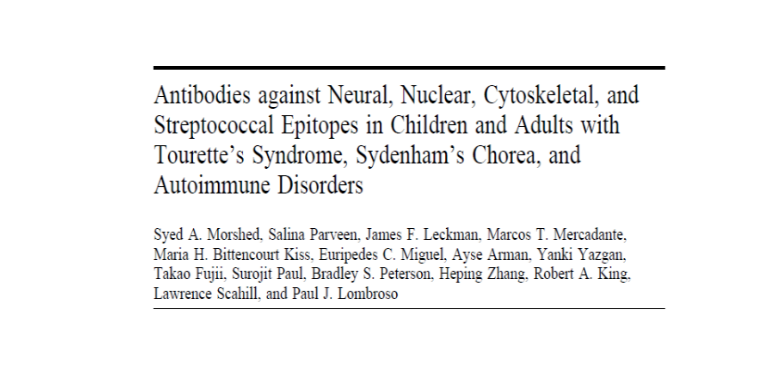Background: Some cases of Tourette’s syndrome (TS) are hypothesized to be caused by autoantibodies that develop in response to a preceding group A beta hemolytic streptococcal infection.
Methods: To test this hypothesis, we looked for the presence ot total and IgG antibodies against neural, nuclear, cytoskeletal and streptococcal epitopes using indirect immunofluorescent assays and Western blot techniques in three patient groups: TS (n = 81), SC (n = 27), and a group of autoimmune disorders (n = 52) and in normal controls (n = 67). Subjects were ranked after titrations of autoantibodies from 0 to 227 according to their level of immunoreactivity.
Results: TS patients had a significantly higher mean rank for total antineural and antinuclear antibodies, as well as antistreptolysin O titers. However, among children and adolescents, only the total antinuclear antibodies were increased in TS patients compared to age matched controls. Compared to SC patients, TS patients had a significantly lower mean rank for total and IgG class antineural antibodies, significantly lower IgG class anticytoskeletal antibodies, and a significantly higher rank for total antinuclear antibodies. Compared to a mixed group of autoimmune disorders, the TS patients had a significantly lower mean rank for total and IgG class antineural antibodies, total and IgG class antinuclear antibodies, IgG class anticytoskeletal antibodies, and a significantly higher rank for antistreptococcal antibodies.
Conclusions: TS patients had significantly higher levels of total antineural and antinuclear antibodies than did controls. Their relation to IgG class antineural and antinuclear antibodies, markers for prior streptococcal infection, and other clinical characteristics, especially chronological age, was equivocal.
Biol Psychiatry 2001; 50:566–577 © 2001 Society of Biological Psychiatry
Key Words: Autoantibodies, molecular mimicry, neuropsychiatric disorders, Tourette’s syndrome, Sydenham’s chorea, autoimmune disorders

